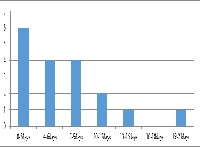Role of laparostomy in preventing early morbidity and mortality in advanced peritonitis patients
Abstract
Background: Very few studies are available for the indication and the need of laparostomy in cases of faecal, biliary peritonitis and gangrenous bowel. The open abdomen procedure is one of the greatest surgical advances in recent times, avoiding the development of abdominal compartment syndrome.
Methods: The present study was a prospective study of the patients who underwent laparostomy during 2yrs study period. Patients who met the inclusion criteria were included in the study. The indications, complications and outcomes of the study were noted.
Results: Majority of the patients are in the age group of 31 to 40yrs. With laparostomy and damage control surgery recovery was seen in 86.6% patients. Post-operative complications were seen in 33.3% of the patients, with electrolyte imbalance, enterocutaneous fistula, anastomotic leak being the most common complications. Deaths were secondary to septicaemia with mortality rate 16.6%.
Conclusion: Laparostomy or open abdomen is a useful emergency measure in certain conditions where there is a need for re-exploration for abdomen and cannot be closed due to gross edema and contamination. It reduces operative time and also facilitates re-look operations.
Downloads
References
Steinberg D. On leaving the peritoneal cavity open in acute generalized suppurative peritonitis. Am J Surg. 1979;137(2):216-220. doi: https://doi.org/10.1016/0002-9610(79)90148-X.
Brian J Daley, Peritonitis and Abdominal Sepsis [Internet]. 2019 Available from: https://emedicine.medscape.com/article/180234.
Leppäniemi AK. Laparostomy: why and when? Critical Care. 2010;14:216. doi: https://doi.org/10.1186/cc8857.
Pieracci FM, Barie PS. Management of severe sepsis of abdominal origin. Scand J Surg. 2007;96(3):184-196. doi: https://doi.org/10.1177%2F145749690709600302
Robledo FA, Luque-de-Leon E, Suarez R, Sánchez P, de-la-Fuente M, Vargas A, et al. Open versus closed management of the abdomen in the surgical treatment of severe secondary peritonitis: a randomized clinical trial. Surg Infect. 2007;8(1):63-71. doi: https://doi.org/10.1089/sur.2006.8.016.
Duff JH, Moffat J. Abdominal sepsis managed by leaving abdomen open. Surg. 1981;90(4):774-778.
Koperna T, Schulz F. Relaparotomy in peritonitis: prognosis and treatment of patients with persisting intraabdominal infection. World J Surg. 2000;24(1):32-37. doi: https://doi.org/10.1007/s002689910007.
Ordonez CA, Sanchez AI, Pineda JA, Badiel M, Mesa R, Cardona U, et al. Deferred primary anastomosis versus diversion in patients with severe secondary peritonitis managed with staged laparotomies. World J Surg. 2010; 34(1):169-176. doi: https://dx.doi.org/10.1007/s00268-009-0285-y.
Sartelli M, Catena F, Ansaloni L, Coccolini F, Corbella D, Moore EE, et al. Complicated intra-abdominal infections worldwide: the definitive data of the CIAOW Study. World J Emerg Surg. 2014;9(1):37. doi: https://dx.doi.org/10.1186/1749-7922-9-37.
Coccolini F, Montori G, Ceresoli M, Catena F, Moore EE, Ivatury R, et al. The role of open abdomen in non-trauma patient: WSES Consensus Paper. World J Emerg Surg. 2017;12(1):39. doi: https://dx.doi.org/10.1186/s13017-017-0146-1.



 OAI - Open Archives Initiative
OAI - Open Archives Initiative


















 Therapoid
Therapoid

